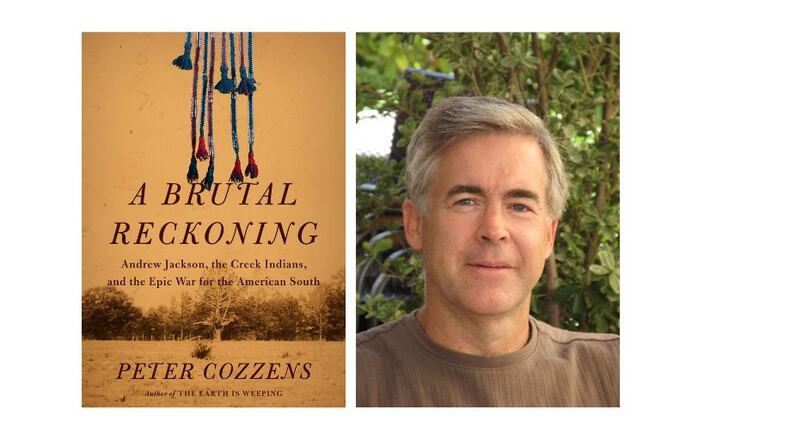“A Brutal Reckoning” is Peter Cozzens’ study of the bloody Creek War (1813-14) and its terrible consequences, to wit, the elevation of Andrew Jackson to national prominence and the ethnic cleansing of Native Americans in the South.
An accomplished military historian, Cozzens’ strong and detailed battle book completes his superlative trilogy, which includes “The Earth is Weeping” (2016), a chronicle of the Indian Wars in the West, and “Tecumseh and the Prophet” (2020), an account of the Shawnee brother-leaders.
“A Brutal Reckoning” calls for an understanding of the Southeastern region in terms of its sinuous river systems that sprawl between Georgia’s coastal plain and the Tensaw, Alabama’s northerly fertile zone. Here, among the Tallapoosa and Coosa rivers, the great battles of the Creek War are fought.
The largest of the southeastern nations, and the focal point of “A Brutal Reckoning,” the Creeks (or Muscogees) “congregated along rivers or their tributaries and reserved most of the land for seasonal hunting.” Cozzens describes their towns, or “talwas,” as having “about as much sense of common purpose as the querulous Italian city-states of Renaissance Europe.” This absence of unity contributes to their downfall.
For the Creeks, " Life was an eternal struggle between peace and war.” They revere a spirit-being, the Master of Breath, and ritualistically imbibe (and regurgitate) a caffeinated beverage called “white drink,” which has the kick of nearly two-dozen cups of coffee.
While Cozzens’ sympathies are with the Creeks (He notes: “Native people prefer to be called by their specific tribal name … [though] “to obtain a better sense of historical immediacy, I most frequently use the term ‘Indian.’”) “A Brutal Reckoning” dispels bucolic myths about tribes living in rose-colored tranquility. They stage community torture spectacles where victims are tied to “blood poles.” They engage in scalping, disembowelment, even ghoulish behavior that Cozzens relates in gruesome detail — atrocities that are often matched by marauding whites.
Divided into Upper Creek and Lower Creek formations, each evolves different worldviews and tactics in response to the relentless encroachment of American settlers over the 18th century.
The expansion of commerce and the mania for land speculation devastate the foundations of Creek society. Acute alcoholism travels along the same river routes that once brought sustenance. A 4-foot wide “postal road,” also known as the Federal Road, is hacked through the wilderness from Athens to Fort Stoddert, north of Mobile.
Tensions arise: Lower Creeks are given to building wealth and raising cattle; Upper Creeks, resistant to change and disliking cows, are roiled by faction.
When Tecumseh personally presents his plan for a pan-Indian alliance to the Upper Creeks in 1811, elders rebuff his visionary proposal. But the magnetic Shawnee chieftain becomes a source of inspiration for younger fighters who launch a militant and mystical movement, the Red Sticks, so-named for their red war clubs, which become both “a symbol and an essential weapon.”
In the history of the Republic, there’s really no oppositional force quite like the quixotic Red Sticks. With their entrance, “A Brutal Reckoning” becomes a chromatic story of heroes and villains who are often both at once. The author would like to restore these obscure, yet important, figures to the mainstream of American narrative.
Tit-for-tat revenge raids by Creeks and whites accelerate, and, inevitably, violence explodes in the 1813 Massacre of Fort Mims. When word reaches Nashville about the Red Sticks’ slaughter of 275 Americans, Tennessee’s political class begins to use the word “extermination.”
Enter Andrew Jackson. Mercurial and paranoid, he’s given to endless outrage: “By the Immaculate God!” he roars. A vicious slave-owner, he punishes his captives with “whips and chains.” A roundly hated commander, he orders the execution a 17-year-old soldier on the bogus charge of desertion.
Wounded twice in a ridiculous affaire d’honneur, he advances against the Creeks with a “mangled shoulder,” barely having “the strength to bear the weight of an epaulet.” The conflict becomes an Homeric back-and-forth, in which the Red Sticks, despite staggering losses, fight the “frontier Caesar” to a “tactical draw.”
The book’s spectacular climax arrives with the Battle of Horseshoe Bend, today merely a two-hour drive from Atlanta’s triumphalist skyline. In a crook of the Tallapoosa River, the Red Stick’s finest war leader, Menawa, constructs “the most imposing Indian-built fortifications the American Army would ever confront.”
Inexplicably, he doesn’t take into account the possibility of an attack from the rear. When frontal assaults fail, Jackson’s Cherokee allies take charge, ford the river and penetrate the citadel from behind, killing 850 Red Sticks. It’s “the largest loss of warrior lives in a single clash on the North American continent.”
The Creek struggle ends and, for the southeastern tribes, millions of acres are ceded. Elected president in 1828, Jackson signs the Indian Removal Act of 1830, a craven betrayal of his erstwhile Cherokee partners who saved him at Horseshoe Bend. Never to be forgotten, the infamous Trail(s) of Tears — a crime against humanity displacing 50,000 Native Americans east of the Mississippi to Oklahoma — will kill thousands.
In his eloquent closing of “A Brutal Reckoning,” Cozzens writes: “No sooner had the Creeks been expelled than slavery cast its baleful net over the rich soil that had run through the Creek heartland. The cotton economy boomed.”
That is, until the Civil War, “a cataclysm for which elderly Creek survivors of the horrors of 1813-1814 might have taken a mordant satisfaction.”
Assuming Peter Cozzens’ ironic longer view, it’s as if all sides lost the Creek War.
NONFICTION
“A Brutal Reckoning”
by Peter Cozzens
Alfred A. Knopf
464 pages; $35
About the Author
Keep Reading
The Latest
Featured


